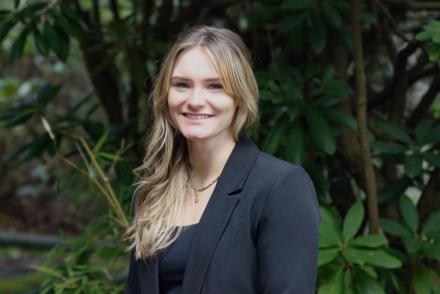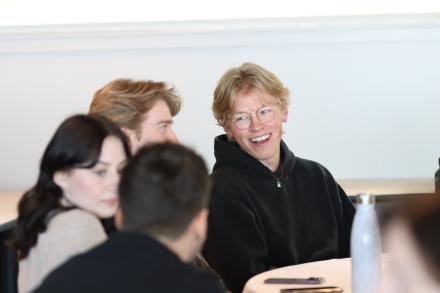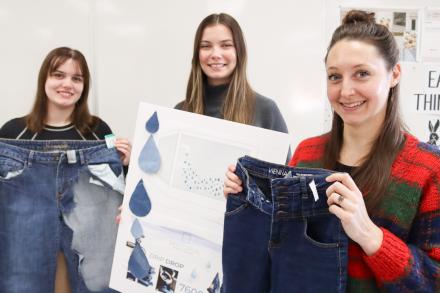Hunter Jarratt’s environmental work has struck a chord on social media
For VIU student Hunter Jarratt, a social media account with a sizeable following and somewhat niche subject matter came about rather unexpectedly.
Hunter, a fourth-year student in the Bachelor of Natural Resource Protection Program, is the creator and personality behind @InvasiveSpeciesGuy on both TikTok and Instagram.
The idea for the account “presented itself as a result of a video going viral overnight back in 2020 – a video outlining an ‘easy snack’ idea,” he recalls. “However, this wasn’t where my passion was.”
Hunter’s real passion is for the natural environment – a passion cultivated while he was a high school student in Campbell River. There, he enrolled in the Outdoor Adventures Program, and met Steve Joyce, the program instructor.
“If not for him and this program, I wouldn’t care about environmental protection as much as I do today. His wisdom, knowledge and lifetime of experience in the outdoors changed me and my perspective of the world. Once I learned about the Natural Resource Protection Program at VIU, I thought this was the most obvious next step in my learning journey.”
Fast-forward to 2020, and Hunter’s viral “snack idea” video. He had spent a month earlier that year removing scotch broom with the BroomBusters branch in Campbell River, and wanted to get back into it.
“I started removing these invasive plants in my spare time and making posts about it and the positive impacts from doing so,” he says. “The content was really well received, I started to build a small community on there, and with a username change, the ‘Invasive Species Guy’ was born.”
Now, with the TikTok account boasting more than 26,000 followers, Hunter says his favourite aspect of the account “has been the connections I have made, and all the learning I’ve done too; I can largely identify the plants growing around me, an idea of their origin statues, conservation statuses, potential uses, what they look like when they go to seed. All of this is incredibly grounding and opens your eyes to the world around you in a new way. It makes you care more about what happens to that world.”
It's a world that’s ever-changing, he adds.
“There are countless invasive plant species found in the province and depending on environmental conditions like available sunlight, temperature, moisture, soil, nutrients and more, you will encounter different invasive plant species.”
The employment side of it varies too, as many positions in this field are seasonal or contract-based, with limited full-time offerings. While there is ample funding for natural resource management – especially for law enforcement or resource extraction-related activities – this is not the case when it comes to the “hands-on” or “non-law enforcement side” of natural resource management. “In my experience, there is less-so and a lack-of for funding and opportunities outside of this realm, especially for hands-on land management or restoration, such as invasive species work,” he says. “This is especially true for full-time positions.”
And “as someone who wants to stay in this line of work, it makes things difficult. The situation is actually quite saddening and discouraging because it’s well-established that constant efforts are required to effectively manage and control invasive species. This is why I have dedicated so much of my personal time to managing invasive species.”
Still, work opportunities do exist “and many organizations are working very hard to protect our biodiversity,” he adds. “And as the climate and biodiversity crises unfold, there will only be more funding and opportunities. With the environmental world in BC being small in the sense that everybody seemingly knows everybody, networking has also had a larger role in this line of work than I had anticipated.”
Hunter’s favourite ecosystem is the Garry oak, which he describes as “a mosaic of woodlands, meadows, grasslands, scattered Douglas-fir stands, open rocky areas and one of the most endangered and biodiverse ecosystems in Canada.” The Garry oak ecosystem is endangered by both the conditions in which it thrives, as well as the ever-expanding human footprint, he explains.
“You’ll find invasive plants like scotch broom, because it thrives in these conditions too. This, combined with constant destruction and disturbance via the unfettered and unmonitored use of off-road vehicles only adds to the problem. This species is the one I deal with most. It overshadows, outcompetes and suppresses native plants, especially native wildflower species. It can change the soil’s chemistry, catches fire easily, most people are allergic to it and it produces thousands of seeds per plant that remain viable in the ground for decades.”
Hunter will graduate from VIU this spring and is working as an ecological restoration assistant under the guidance of Biology Professor Dr. Caroline Josefsson at the Garry oak habitat restoration plot at the VIU Nanaimo campus. After he graduates, he hopes to find full-time work in conservation and land management, “hopefully with a direct connection to invasive species.”
He also reminds people that they can also get involved with the battle against invasive species, using phone apps like INaturalist or Seek to identify unfamiliar plants, animals or insects.
“If it is an invasive species, the proper actions can then be taken to address that,” Hunter says. “Removing invasive species anywhere requires persistence and a strong commitment. However, the results are absolutely worth it, and in my experience working in Garry oak ecosystems, where scotch broom has been removed, it only takes a short amount of time for native biodiversity to largely return.”
Related Posts
Got an article idea for the blog? Email students@viu.ca.



